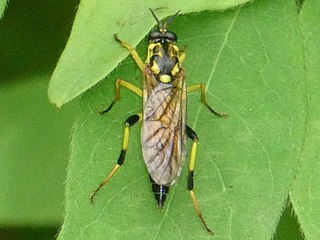
The Fauna of British India with long titles including The Fauna of British India, Including Ceylon and Burma, and The Fauna of British India Including the Remainder of the Oriental Region is a series of scientific books that was published by the British government in India and printed by Taylor and Francis of London. The series was started sometime in 1881 after a letter had been sent to the Secretary of State for India signed by Charles Darwin, Sir Joseph Dalton Hooker and other "eminent men of science" forwarded by P.L.Sclater to R.H. Hobart. W. T. Blanford was appointed editor and began work on the volume on mammals.

The soldier flies are a family of flies. The family contains over 2,700 species in over 380 extant genera worldwide. Larvae are found in a wide array of locations, mostly in wetlands, damp places in soil, sod, under bark, in animal excrement, and in decaying organic matter. Adults are found near larval habitats. They are diverse in size and shape, though they commonly are partly or wholly metallic green, or somewhat wasplike mimics, marked with black and yellow or green and sometimes metallic. They are often rather inactive flies which typically rest with their wings placed one above the other over the abdomen.

The Brachyceran family Vermileonidae is a small family of uncertain affinities and unusual biology. It includes fewer than 80 described species, most of them rare and with restricted distribution, in 11 genera. Historically the vermileonids had been regarded as belonging to the family Rhagionidae, possibly in a subfamily Vermileoninae. Their biology and morphology are so markedly distinct from the main Rhagionidae sensu stricto however, that the placement as a separate family has been widely accepted.

Xylomyidae is a family of flies known commonly as the wood soldier flies. They are xylophagous and are associated with dead or dying wood.

Apsilocephalidae is a family of flies in the superfamily Asiloidea. It was historically treated as a subfamily within Therevidae, but placed in a separate family in 1991, and subsequently recognized as more distantly related. The family contains three extant genera and at least five extinct genera described from the fossil record.

Actina chalybea is a species of 'soldier flies' belonging to the family Stratiomyidae subfamily Beridinae.
Oxycera analis, the dark-winged soldier, is a species of soldier fly.
Brian Roy Stuckenberg was a South African entomologist who specialised in Diptera.

Solva is a fly genus in the family Xylomyidae, the "wood soldier flies".

Xylomya is a fly genus in the family Xylomyidae, the "wood soldier flies".
Xylomya tenthredinoides is a species of fly in the family Xylomyidae.
Xylomya americana is a species of fly in the family Xylomyidae.
Xylomya parens is a species of fly in the family Xylomyidae.

Xylomya terminalis is a species of fly in the family Xylomyidae.

Solva pallipes is a species of fly in the family Xylomyidae. It is found throughout most of North America.
Xylomya pallidifemur is a species of fly in the family Xylomyidae.
Xylomya simillima is a species of fly in the family Xylomyidae.
Arthropeina fulva is a species of fly in the family Xylomyidae, the "wood soldier flies".
Protovermileo is an extinct genus of wormlion in the family Vermileonidae. It contains only the species Protovermileo electricus, which is known from Baltic amber.








